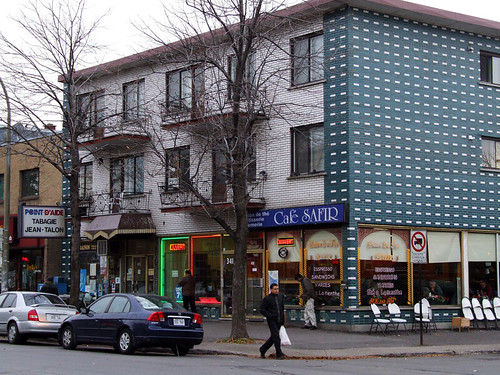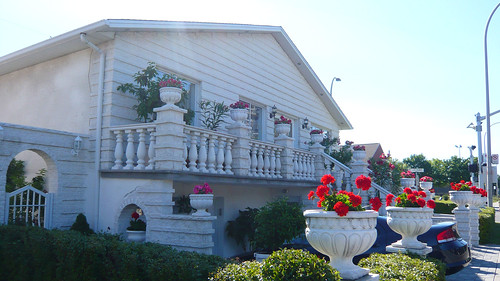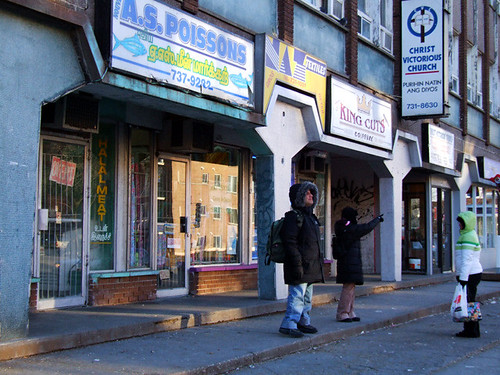
Jean Talon Street in Saint Michel
For all of its historic neighbourhoods, Montreal is really a postwar city. In the twenty years after 1941, the number of people living on the island swelled from 1.1 million to well over 1.7 million and tens of thousands of new apartment buildings, plexes and houses were built to accommodate the steadily growing population. Old neighbourhoods expanded, new neighbourhoods were built and the suburbs blossomed, stretching east and west towards the edges of the island.
Lately, I’ve found myself drawn to these parts of town, placers where the urban fabric seems raw and unpolished despite its relatively recent vintage. For the urban wanderer, there are plenty of discoveries to be made.

House in Ville d’Anjou. Photo by Kate McDonnell
Each generation of Montreal neighbourhoods has its own architectural vernacular; those that developed in the early postwar period are no exception. After World War II, the use of outdoor staircases were restricted by new building codes, so staircases shifted indoors. In many buildings, the decorative features of prewar buildings gave way to a sometimes elegant simplicity, though it must be said that, towards the end of the 1950s and throughout the 1960s, some buildings went the opposite direction, plunging into an ocean of roccoco kitsch — just look at St. Leonard and Ville d’Anjou.
In a North American context, postwar development is usually characterized as auto-oriented and suburban. In Montreal, though, most of what was built in the 1940s and 50s, and even well into the 1960s, was fairly urban, consisting of multi-family dwellings located near retail streets. This has made these postwar neighbourhoods particularly apt for regeneration as they take in successive waves of immigrants.
Victoria Avenue in Côte des Neiges is a perfect example. Its modern commercial blocks, apartment buildings and duplexes, built in the late 1940s and early 1950s for a growing middle class, are now home to immigrants from dozens of countries. Filipinos, Russians, Jamaicans, Indians, Chinese and Jews are some of the more prominent ethnic groups that share this homely neighbourhood.

1950s commercial architecture on Victoria Avenue
St. Michel, which boomed in the 1940s after housing for returning veterans was built in its western reaches, is similar. East of St. Michel Blvd., on a strip of Jean Talon that was once mostly Italian, North African immigrants have opened up shop in a neighbourhood that is now being called Little Maghreb. Further to the south, on Bélanger around St. Michel, restaurants serving “cuisine creole,” like the Casse-Croûte Steve Anna, sidle up to Italian hair salons, a Haitian Pentecostal church and a Vietnamese Buddhist meditation centre.

4 comments
“what might best be described as the most Toronto-like parts of Montréal.” Yes but not by the writer.
Indeed…and that’s a pretty strange statement anyway. Like what, in Toronto? Show me photos of Victoria Ave and Eglinton side by side…and I will show you photos of Queen and St-Laurent. Montreal does have a somewhat longer history than T-O, which shows in a few places, but for the most part the cities are of VERY similar vintages.
A leap from 1.1 to 1.7 million postwar does NOT make Montreal a “postwar city”. Most older cities have experienced postwar growth, except those that had reached their official boundaries and no longer incorporated new suburbs (Paris, Boston…).
Ugly as most postwar neighbourhoods are (due to the car?)people have made them living places and that is worth recording. But not glorifying.
…New York, London, Philadelphia, Chicago…all shrank after the war.